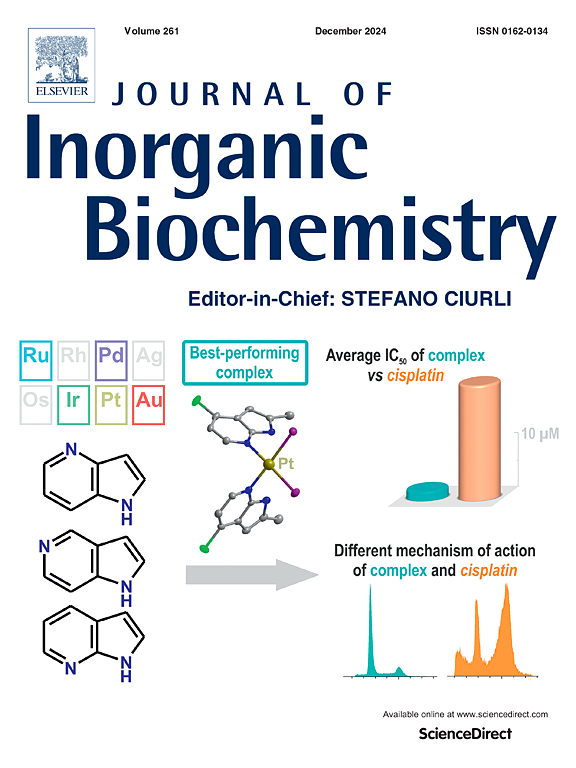The antibacterial activity and selectivity of bismuth(III) tris(8-hydroxyquinolinates)
IF 3.8
2区 化学
Q2 BIOCHEMISTRY & MOLECULAR BIOLOGY
引用次数: 0
Abstract
The series of bismuth(III) tris(8-hydroxyquinolinates); [Bi(Q")3] (1), [Bi(Q'Cl)3] (2), [Bi(QCl2)3] (3), [Bi(QBr2)3] (4), and [Bi(QI2)3] (5) (where Q"-H = C9H7NO; Q'Cl-H = C9H6NOCl, QCl2-H = C9H5NOCl2; QBr2-H = C9H5NOBr2; and QI2-H = C9H5NOI2) were synthesised, fully characterised, and evaluated for their antibacterial activity towards three Gram-positive bacteria (vancomycin-resistant E. faecalis, S. aureus, methicillin-resistant S. aureus), and four Gram-negative bacteria (A. baumannii, P. aeruginosa, K. pneumoniae, and E. coli) and also their cytotoxicity towards mammalian cells. New crystallographic data on 4 indicates it is dimeric in the solid state through ‘Bi2O2’ bridging which is consistent with data previously reported for 5. The five complexes (1–5) all exhibited good but variable antibacterial activity and selectivity. Complexes 2 and 5 showed significant activity towards Gram-positive bacteria with MIC (minimum inhibitory concentration) values ranging from 0.78 μM – 3.13 μM and selectivity indices of 6.2 – ≥16.0. For Gram-negative species, complexes 3 and 4 exhibited highly selective activity towards multi-drug resistant strains of A. baumannii with a range of MIC values 0.39–1.56 μM and selectivity indices of 3.14–7.23 respectively. While some of the 8-hydroxyquinolines themselves show reasonable antibacterial activity this is generally enhanced through complexation to bismuth(III).

三羟基喹啉酸铋(III)的抗菌活性和选择性
三羟基喹啉酸铋(III)系列;[Bi (Q) 3] (1), (Bi (Q 'Cl) 3) (2), (Bi (QCl2) 3) (3), (Bi (QBr2) 3)(4)和(Bi (QI2) 3) (5) (Q - h = C9H7NO;Q'Cl-H = C9H6NOCl, qcl - h = C9H5NOCl2;qbr - h = C9H5NOBr2;和QI2-H = C9H5NOI2)的合成,充分表征,并评估其对三种革兰氏阳性菌(耐万古霉素的粪大肠杆菌、金黄色葡萄球菌、耐甲氧西林的金黄色葡萄球菌)和四种革兰氏阴性菌(鲍曼不动杆菌、铜绿假单胞菌、肺炎克雷伯菌和大肠杆菌)的抗菌活性以及对哺乳动物细胞的细胞毒性。4的新晶体学数据表明,通过“Bi2O2”桥接,它在固态中是二聚体,这与先前报道的5的数据一致。5种配合物(1-5)均表现出良好的抗菌活性和选择性。配合物2和5对革兰氏阳性菌具有显著的抑制活性,最小抑制浓度(MIC)为0.78 μM ~ 3.13 μM,选择性指数为6.2 ~≥16.0。在革兰氏阴性菌株中,配合物3和4对鲍曼不动杆菌多重耐药菌株具有较高的选择性活性,其MIC值分别为0.39 ~ 1.56 μM,选择性指数为3.14 ~ 7.23。虽然一些8-羟基喹啉本身表现出合理的抗菌活性,但通常通过与铋(III)络合而增强。
本文章由计算机程序翻译,如有差异,请以英文原文为准。
求助全文
约1分钟内获得全文
求助全文
来源期刊

Journal of Inorganic Biochemistry
生物-生化与分子生物学
CiteScore
7.00
自引率
10.30%
发文量
336
审稿时长
41 days
期刊介绍:
The Journal of Inorganic Biochemistry is an established international forum for research in all aspects of Biological Inorganic Chemistry. Original papers of a high scientific level are published in the form of Articles (full length papers), Short Communications, Focused Reviews and Bioinorganic Methods. Topics include: the chemistry, structure and function of metalloenzymes; the interaction of inorganic ions and molecules with proteins and nucleic acids; the synthesis and properties of coordination complexes of biological interest including both structural and functional model systems; the function of metal- containing systems in the regulation of gene expression; the role of metals in medicine; the application of spectroscopic methods to determine the structure of metallobiomolecules; the preparation and characterization of metal-based biomaterials; and related systems. The emphasis of the Journal is on the structure and mechanism of action of metallobiomolecules.
 求助内容:
求助内容: 应助结果提醒方式:
应助结果提醒方式:


